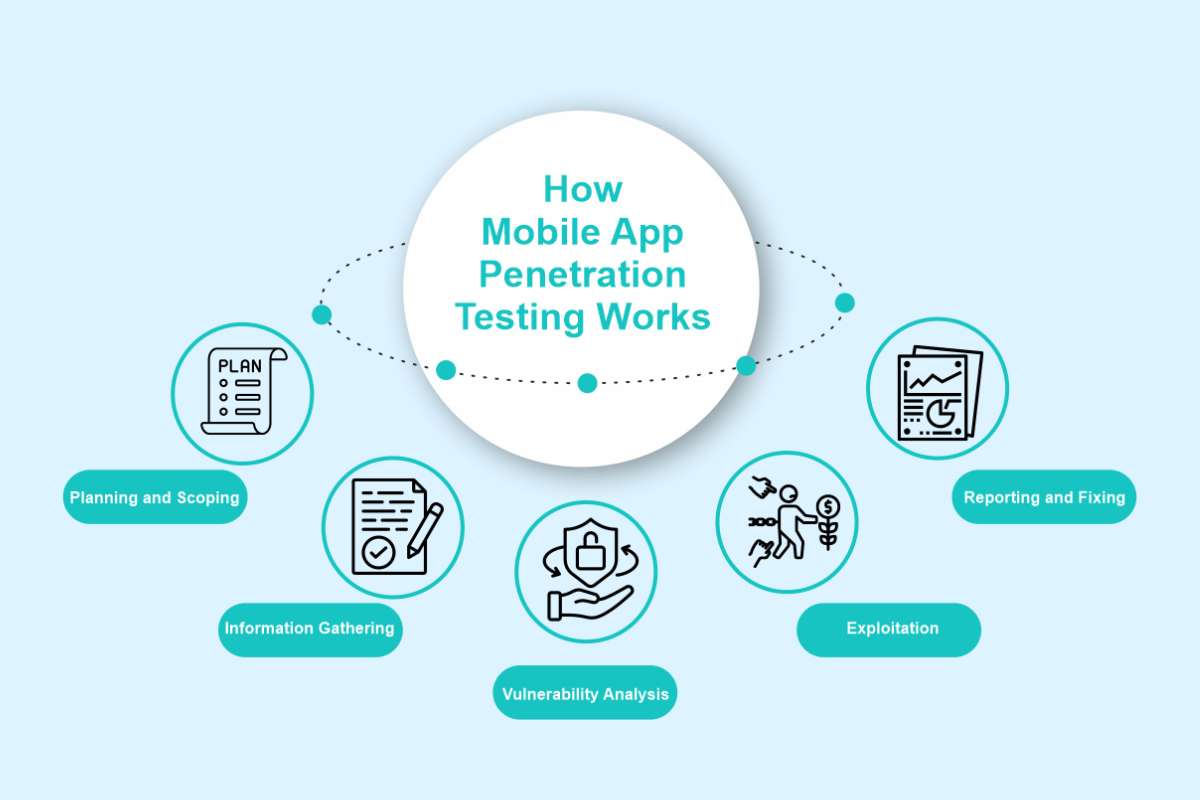
- Source: (vumetric.com)
Mobile app penetration testing is a way to check if installed applications are safe from hackers. Experts act like cyber attackers to find weak spots and fix them. It includes different methods like Black Box Testing (no app knowledge), White Box Testing (full app access), and Grey Box Testing (partial access). The process involves planning, testing, and fixing issues. It helps protect user data, prevents money loss, and builds customer trust. Regular testing is necessary to keep apps safe from online threats.
When I started using mobile applications for banking and shopping, I never really thought about their security. I thought they were safe, but after some time, I heard about a data breach where thousands of user’s information was leaked. That is when I became curious about how mobile apps are protected. Then, I discovered mobile app penetration testing. It is a process where security experts test apps to find and fix vulnerabilities before hackers can exploit them. This made me realize how important penetration testing is for keeping our data safe.
It gave me a new perspective on app security and the risks we often overlook. In this blog, we will explore the meaning of mobile app penetration testing, its importance, and how it helps protect users and businesses from cyberattacks.
What is Mobile App Penetration Testing?
Mobile App Penetration Testing (MAPT) is a security process where experts simulate cyberattacks on a mobile application. The main goal is to find vulnerabilities that hackers could use to steal data, inject malware, or take control of the application. It is like hiring ethical hackers to break into your app to identify weak spots before real hackers. This testing is done on both Android and iOS apps to confirm that they are safe and secure.
Types of Mobile App Penetration Testing

1. Black Box Testing –
- In Black Box Testing, the tester has no prior knowledge of the app’s internal structure.
- They act like external hackers trying to exploit the app.
- This testing simulates a real-world attack.
2. White Box Testing –
- In White Box Testing, testers have full access to the app’s source code and architecture.
- It helps in identifying internal vulnerabilities and coding flaws.
3. Grey Box Testing –
- Grey Box Testing combines Black and White Box approaches.
- Testers have partial knowledge of the structure of the app.
- This method tests both external and internal vulnerabilities.
How Mobile App Penetration Testing Works?

1. Planning and Scoping
The testing team defines the testing scope, including the application features, data handling, and security controls.
2. Information Gathering
Testers collect data about the app, like the type of platform (Android/iOS), APIs used, and third-party integrations.
3. Vulnerability Analysis
The app is tested for security flaws like data leaks, insecure storage, or weak authentication.
4. Exploitation
The testers attempt to exploit the vulnerabilities to see if they can gain access to sensitive data.
5. Reporting and Fixing
The findings are documented, and developers are given detailed reports to fix the issues.
Steps in Mobile App Penetration Testing

Step 1 – Planning and Scope:
Define the goals and boundaries of the test.
Step 2 – Information Gathering:
Collect app details like platform, APIs, and backend.
Step 3 – Static Analysis
Review the app’s code for security flaws.
Step 4 – Dynamic Analysis
Test the app while it is running to find vulnerabilities.
Step 5 – Exploit and Attack:
Simulate real-world attacks to identify weaknesses.
Step 6 – Data Analysis
Review and analyze the test results.
Step 7 – Reporting
Create a report with findings and recommendations.
Step 8 – Fix and Retest
Fix issues and run the test again to confirm security.
Benefits of Mobile App Penetration Testing
- Protect application data from hackers or other infected applications.
- Improve customer confidence through enhanced security.
- Prevent financial losses that may be caused by a security breach.
- Improve the responsiveness and resilience of your IT teams.
- Check and meet industry security standards and comply with regulations.
Conclusion
Mobile app penetration testing is important to keep mobile apps safe. It helps find weak spots, stops data leaks, and protects user’s private information. By testing apps regularly, businesses can earn their customer’s trust and follow data protection rules. In the Digital world, where online threats keep growing, mobile app penetration testing is a must, not a choice. By focusing on security, companies can offer safer and more reliable apps to their users.